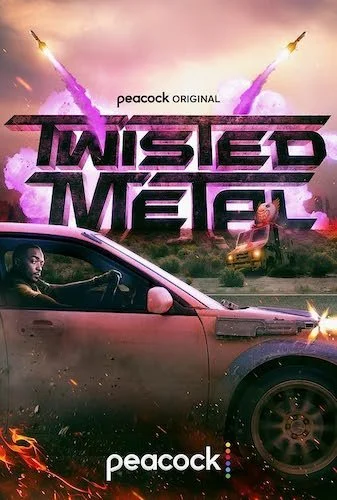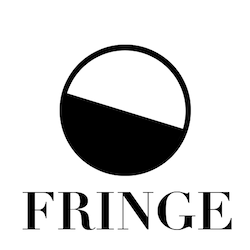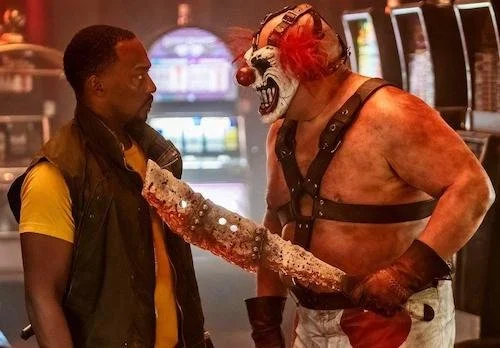Twisted Metal: Binge, Fringe, or Singe?
Written by Andreas Babiolakis
Binge, Fringe, or Singe? is our television series that will cover the latest seasons, miniseries, and more. Binge is our recommendation to marathon the reviewed season. Fringe means it won’t be everyone’s favourite show, but is worth a try (maybe there are issues with it). Singe means to avoid the reviewed series at all costs.
Slipknot was my bridge from rock music to metal when I was a kid looking for intense music. A Clockwork Orange was a film I watched when I was way too young but it was the start of my obsession with disturbing films. Yes, many youths that grew up in the nineties craved that edge that the dawn of the internet and the height of polarizing, in-your-face entertainment provided. Case in point: the Twisted Metal video game series was my foray into shoot-em-ups when I was younger than ten years old. This wasn’t Grand Theft Auto, but it was rooted in fantasy enough that the games didn’t carry the same notoriety when the series was young. If anything, it was considered more “fun” than disturbing likely because of the bumping soundtrack (consisting of Rob Zombie, Cyprus Hill, Rob Zombie, Pitchshifter, Rob Zombie, Rob Zombie… wait, who else was featured in these games?) and the unserious nature that most of the games possessed. I suppose once 989 Studios (remember them?) took on the series, they were marketed and crafted around the idea of competitive sports and electricity more than anything else. It was kind of the perfect gateway game for many of us that were too young to be bought mature titles (if not the Nintendo 64 classics GoldenEye 007 and Perfect Dark, I would argue).
The Twisted Metal series has players selecting vehicles that are clad in machine guns and rocket launchers as they try to take out opponents one by one. It’s like your typical third-person shooter, only much faster and chaotic; it’s difficult to take on a stealth-based strategy here. The point? For each “contestant” to be the last one standing and win a contest where their wishes are granted. I’ll go ahead and state that most of the Twisted Metal games have aged poorly (outside of the second one being quite consistent and the first game, despite the latter’s graphics). The third title is where it all started for me, but it’s quite noisy and nauseating when revisited nowadays. 4 at least granted us some customizability with the options to make our own vehicles and maps, but they’re quite limiting in hindsight. We don’t talk about Small Brawl (but, then again, who does?). The only title I still care a great deal about is the most mature release from what I have played: Twisted Metal: Black. One of the greatest titles for the PlayStation 2, Black is much more morbid and frightening, as you feel the weight of every attack your vehicle receives (even if you are Dollface operating the giant truck Darkside, but especially if you are Mr. Grimm zipping around in a puny motorcycle like a sitting duck). Each character had stronger storylines about morality and mortality, as opposed to the sillier premises before, and the contest felt more like a carnival of desperation. If you want a challenging, obsidian game from yesteryear, I cannot recommend Twisted Metal: Black enough.
Finally, let’s get to this new Peacock original series. I felt the need to preface this review with some backstory because it is important in understanding what developers Rhett Reese, Michael Jonathan Smith, and Paul Wernick were dealing with when adapting the games into a ten-episode season. The original promotional materials actually looked horrendous. The original games were silly, but not to the extent that this series was promising to be. The show appeared to be heavily rooted in nostalgia and juvenile humour. There wasn’t a hint of what the best of the series, Black, was in sight. I held my breath and ventured forth into the first season. I knew it wasn’t going to be as good as it should have been given the wild direction the show went: eccentric instead of captivating. However, colour me shocked because Twisted Metal is not a complete disaster. In fact, it’s quite watchable. It isn’t what I could have ever hoped for in an adaptation, but it actually is decent. Looking back, maybe adapting these games into a cohesive, narrative-based series is a tall order because of how much the story relies on your experience making it out of each blood-bathed round alive. Sure, Black had stories upon stories with most of the characters’ arcs being handled really well, but could a series cover all of them sufficiently? Maybe. Maybe not.
The show is based on John Doe: arguably the most anchored character they could have chosen. He is played by Anthony Mackie, who I will continue to call one of the best actors of his generation. This is also true in Twisted Metal, where the especially clunky preliminary episodes are carried single-handedly by how well he elevates corny writing via charm and gravitas. Thank goodness for this as well, because Twisted Metal slowly gets more and more interesting as it continues, despite its temporary deviation from the games entirely outside of its characters (there are a few episodes that are barely about vehicular combat at all, but that makes sense when the series forgoes constant action to tell its story: a sacrifice I will always accept).
Twisted Metal isn’t a basic competition where the last driver standing wins a big wish. It’s been adapted into a post-apocalyptic world (one ravaged by an inexplicable disaster that wipes out a majority of civilization) where the drivers are typically deliverers of goods and contraband; they have to arm themselves to fend off bandits, thieves, and opposition. Each city is walled off to protect those living inside, so their only access to what they need is these drivers that bring them what they need. The whole “wish” element is granted to John Doe through Raven who is apparently assuming the role of Calypso (as “wish granter”, I suppose, although he is alluded to in the series) from the video games (or so we think: keep watching). Raven promises John Doe a proper life: one that he cannot remember because of many years of being a “milkman” that risks his life making deliveries on a daily basis. Of course, what John Doe doesn’t see is that this is a front that Raven has put on and her actual reasons for sending John Doe on a trip from the west coast all the way to “New Chicago” aren’t known at first. All we can tell is that John Doe has a delivery to complete with a fake reward in mind.
Twisted Metal aims to tell a fun-yet-bloody story that occasionally works when it isn’t overwhelming noise.
John Doe is quickly joined by Quiet: a brand new character for the show. I typically would question the choice of making an original role for a well-established series, but Twisted Metal kind of lends itself to the idea of having new faces join in on the fun (if anything, a lot of the pseudonyms that popped up in multiple games would sometimes represent different people, Spectre being a good example as the vehicle encompassed Scott Campbell, Ken Masters, Lance Wilder, and Bloody Mary, to name a few of the drivers that went under the same alias across different games). The one constant name that most players wanted to read is “Sweet Tooth”: a psychotic, serial killer clown that drives an ice cream truck that possesses a bobbling clown head on its rooftop. His popularity and unique design made him an easy mascot for the franchise, so he is easily the most recognizable character from any of these games that has ascended to the heights of Playstation lore. Well, Sweet Tooth is here in all of his demonic glory, and he even gets his own subplot (the tag team of Joe Seanoa playing Sweet Tooth and Will Arnett providing his voice is a terrific one).
John Doe and Quiet are forced to cooperate at first, but they then start to confide in one another. This story is about their union while the world falls apart around them. Some backstories are provided for them and for other characters, including Sweet Tooth’s youthful reason for his brain snapping in half, and Agent Stone — a corrupt officer who enforces his authority every which way — and his early days where he wasn’t taken seriously. Throughout this series, I couldn’t help but think of another eclectic, loud, darkly-comedic property: The Boys. The main difference is that The Boys possesses a major dose of commentary about superhero culture, society’s propensity for both happy endings and cancellations, and commercialism. It deconstructs what it is satirizing while rebuilding it in a clever, telling way. Twisted Metal doesn’t really comment on video games or the insanity of its characters at all, as much as it provides context for their existence. Twisted Metal may be as much fun as The Boys, but it isn’t remotely as profound. Not that it needed to be, but it’s easy to see what a better series could have been outside of what we get: society is a ticking time bomb waiting to collapse and pushing people enough will break them either physically or mentally. Where else have we heard this? Well, pretty much everywhere lately.
Tossing Twisted Metal: Black back on reminds me of how much more we got in bite-sized cutscenes, including a soldier reduced to cannibalism to survive, a preacher trying to exorcise himself instead of actually tending to his mental delusions, or a boxer whose eyes were gouged out and his mouth sewn shut (how he drives around and aims rockets and bullets at enemies, I’ll never quite figure out). The only slice of pop culture we got in this game was The Rolling Stones’ “Paint it Black” played over the ending credits, and I will never complain about that song being used (no matter how many times it is). The Twisted Metal series is reference after reference, joke after joke, and pop culture staple after pop culture staple. It almost relies on its nostalgia — to bring you back to the time that the games came out — more than it trusts its narrative depth, particularly because Twisted Metal starts extremely wobbly with its excessive volume and chaos demanding that you love it.
There is some narrative goodness here after all. As the series progresses and we get deeper into the psyches of the characters. I love Sweet Tooth’s revelations the most, but Agent Stone also gets some fascinating context that makes him a love-to-hate figure in the series. For every bit that I respect, there’s something I cannot that seems so distanced from the games and any dignified story; such an example is the running bit of the guy with the giant penis that can crush almost anything (I don’t remember anything like this in the game, so you’ll have to find someone else to blame for this). I believe in separating a new creation from its source material if you can trust me or not, so I won’t complain about how little of this series is actually based on the vehicular combat that made the video games so loveable. I don’t think these elements would make for great television on their own, and it is nice to see how much work was put into this series for it to stand on its own two legs. The show indeed bears very little resemblance to its source material, but there’s enough of both worlds (the self-aware antics of the first string of games, and the deep-enough backstories and drives of Black), but it’s almost for the best that the show aimed to be its own property.
The only thing is that Twisted Metal itself is a bit of a hodge-podge between surprisingly good elements and occasional annoyances and pitfalls. I feel distanced from the show whenever it carries on its umpteenth Deadpool-esque joke, but I am compelled to watch more when I get juicier world-building and character development. What I can say is that I can sense some potential promise for any upcoming seasons should they happen (this first stretch certainly promises lots to come, in a far more traditional sense regarding the games), but I also can see Twisted Metal being cancelled; I haven’t heard much of a splash since this series dropped at all, and I also can’t imagine everyone feeling intrigued by this release after the fact (but you never know). What I can say is that Twisted Metal is at least partially fun. When it isn’t trying too hard, it achieves the thrill of the video game, even if it is in its own peculiar way that shares very little common ground with its source material (and that, in and of itself, is kind of curious). Not to create a road-related pun for a franchise built on reckless driving, but I wish Twisted Metal picked a lane and stuck with it. Either go the superficial route entirely (less preferred) or go fully, darkly fascinating (ding ding ding). When you have a character from Twisted Metal: Black — Preacher — show up in the series with his extremely distressing backstory acting like a buffoon, neither side of the character works well despite the rich source material provided.
Having said all of this, I was anticipating Twisted Metal to be hopeless, and it actually is far from that. I was entertained. I was fine with catching all ten episodes in a row. While we could have had a much better show, we also nearly got a disastrous one. Twisted Metal has a lot to critique as you can see, but it has a bit to celebrate too. For action junkies, this is a fun, five-hour run that slowly becomes a pulpy story as it continues forth and gets better. Some scenes feel like they are underproduced, but that realization doesn’t last long with the majority of magnetic performances you see on-screen at any given moment. Quite a few jokes fall flat, but some stick their landing and feel fresh. It’s naturally the darker side of Twisted Metal which works the best, but it isn’t half bad as it currently stands. You’ll have to excuse quite a bit, but you’ll also find rewards where you weren’t looking. Perhaps we have been spoiled with Arcane and The Last of Us because it wasn’t too long ago when Twisted Metal would have been one of the best adaptations of a video game out there. I’m happy that this isn’t the case and that the bar has been raised quite a bit, but it’s also quite something that Twisted Metal is far from the worst adaptation of a video game property. Enjoy it for what it is. It may not come back. We were prepared for something far worse.
Andreas Babiolakis has a Masters degree in Film and Photography Preservation and Collections Management from Toronto Metropolitan University, as well as a Bachelors degree in Cinema Studies from York University. His favourite times of year are the Criterion Collection flash sales and the annual Toronto International Film Festival.





